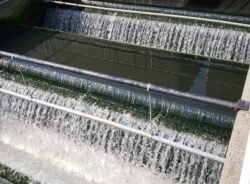
Brightwater Treatment Plant

Brightwater Treatment Plant: A Pillar of Sustainability for the Community
Introduction
Water treatment plants are critical to maintaining public health, environmental safety, and high living standards in any community. The Brightwater Treatment Plant, esteemed for its advanced technological features and dedicated service, stands out as a prime example of how modern engineering and community cooperation can merge to offer an essential public good. This article delves into the various facets of the Brightwater Treatment Plant, from its operational capacity and population served to recent updates and community projects.
A Marvel of Modern Engineering
Serviced Population
Situated in the heart of Washington State, the Brightwater Treatment Plant services the wastewater needs of a substantial population. With an estimated population of over 1.5 million people in the King and Snohomish Counties, the plant’s operations affect a broad swath of the regional populace. Brightwater is strategically designed not only to address the current demand but also to accommodate future growth, considering the expanding urban and suburban landscapes.
Wastewater Volume and Treatment Capacity
On average, the Brightwater Treatment Plant processes approximately 36 million gallons of wastewater every day. However, its infrastructure is robust enough to treat up to 54 million gallons per day (MGD), accommodating periods of peak usage. This treatment capacity ensures that the plant can handle everything from regular daily flows to sudden surges due to stormwater and other temporal influences.
Cutting-Edge Treatment Technology
Primary Treatment
The treatment process at Brightwater starts with preliminary screening to remove large debris and particles. Following initial filtration, the wastewater undergoes primary treatment involving sedimentation tanks where solids are allowed to settle. These preliminary steps are crucial for reducing the load on subsequent treatment phases.
Secondary Treatment
The secondary treatment stage employs advanced biological treatment processes. Activated sludge systems and aerated bioreactors are utilized to break down organic matter by harnessing the metabolic processes of bacteria and other microorganisms. This phase is essential for significantly reducing biological oxygen demand (BOD) and suspended solids.
Tertiary and Advanced Treatments
At Brightwater, tertiary treatment steps are implemented to further polish the effluent. These include chemical precipitation, advanced filtration, and ultraviolet (UV) disinfection. The entire treatment process ensures that the water released back into the local streams and Puget Sound is safe and meets stringent regulatory standards.
Recent Local News and Upgrades
Expansion Plans: Future-Proofing the Facility
In light of continuing population growth and environmental challenges, the Brightwater Treatment Plant recently announced plans to undertake a significant expansion project. This multi-million-dollar venture aims to increase the plant’s treatment capacity to 72 MGD, which will further bolster its ability to manage increasing wastewater volumes efficiently.
Resilience Against Climate Change
The plant has also been in the news for its proactive steps in countering the impacts of climate change. Rising sea levels and increasingly unpredictable weather patterns necessitate adaptive infrastructure. Brightwater is currently investing in stronger seawalls and enhancing stormwater management systems to ensure uninterrupted operations even during adverse weather conditions.
Renewable Energy Initiatives
In recent years, Brightwater has gained attention for its strides in sustainability. The plant utilizes biogas produced during anaerobic digestion as a renewable energy source to power its facilities. Coupled with solar panel installations and energy-efficient machinery, Brightwater is on track to become a net-zero energy facility within the next decade.
Key Projects and Innovations
Biosolids Recycling
One of the standout projects at Brightwater is its biosolids recycling program. The plant transforms municipal sludge into nutrient-rich biosolids, which are then utilized as fertilizers in agriculture. This not only tackles waste but also provides an eco-friendly alternative to chemical fertilizers, enriching the soil without causing harm.
Wetland Restoration and Habitat Creation
In an effort to mitigate its ecological footprint, Brightwater has undertaken several environmental enhancement projects. Recent initiatives include the restoration of nearby wetlands and the creation of new habitats for local flora and fauna. These projects not only compensate for the disruption caused by plant operations but also contribute positively to regional biodiversity.
Community Educational Programs
Recognizing the importance of community education in fostering sustainable practices, Brightwater has launched several educational outreach programs. These include guided tours, interactive workshops, and public seminars that educate residents about water conservation, pollution control, and the intricacies of wastewater treatment.
Community Engagement and Public Relations
Open Day Events
Brightwater Treatment Plant frequently hosts Open Day events where the public can tour the facility, interact with staff, and gain a comprehensive understanding of how wastewater is treated. These events often draw significant attendance and serve as fertile ground for fostering community trust and transparency.
Collaboration with Local Schools
As part of its commitment to education, Brightwater collaborates extensively with local schools. Educational programs designed for different age groups aim to instill a sense of environmental stewardship from a young age. These initiatives include field trips to the plant, classroom presentations, and hands-on science projects related to water treatment and conservation.
Public Feedback Mechanisms
In an effort to maintain continuous improvement, Brightwater has implemented various channels for community feedback. These include public forums, online surveys, and suggestion boxes placed at local community centers. The feedback is meticulously reviewed and often serves as a basis for new initiatives and improvements.
Conclusion
The Brightwater Treatment Plant is much more than a cornerstone of infrastructure; it is an embodiment of the community’s commitment to sustainability, ecological responsibility, and public health. Its state-of-the-art technology and comprehensive treatment processes ensure that wastewater from King and Snohomish Counties is managed in an efficient, environmentally friendly manner. Coupled with its continuous community engagement and educational efforts, Brightwater stands as a model facility in the realm of wastewater treatment and environmental stewardship. By continually evolving and adapting to new challenges, it not only meets current needs but also proactively prepares for future demands, ensuring that it remains an integral asset for generations to come.
